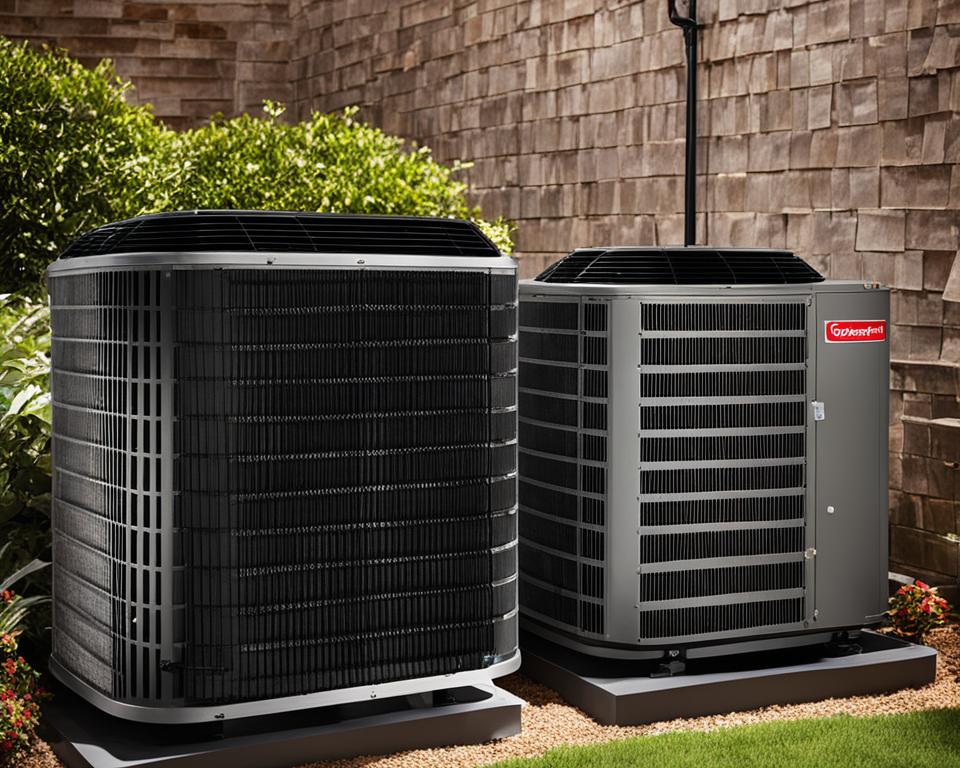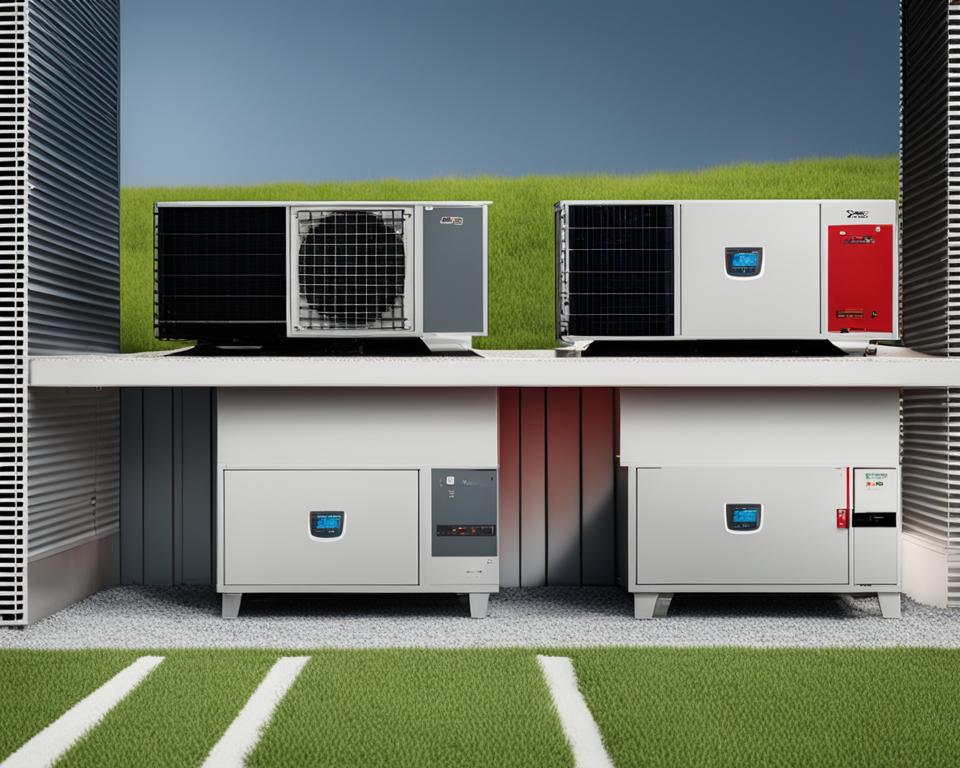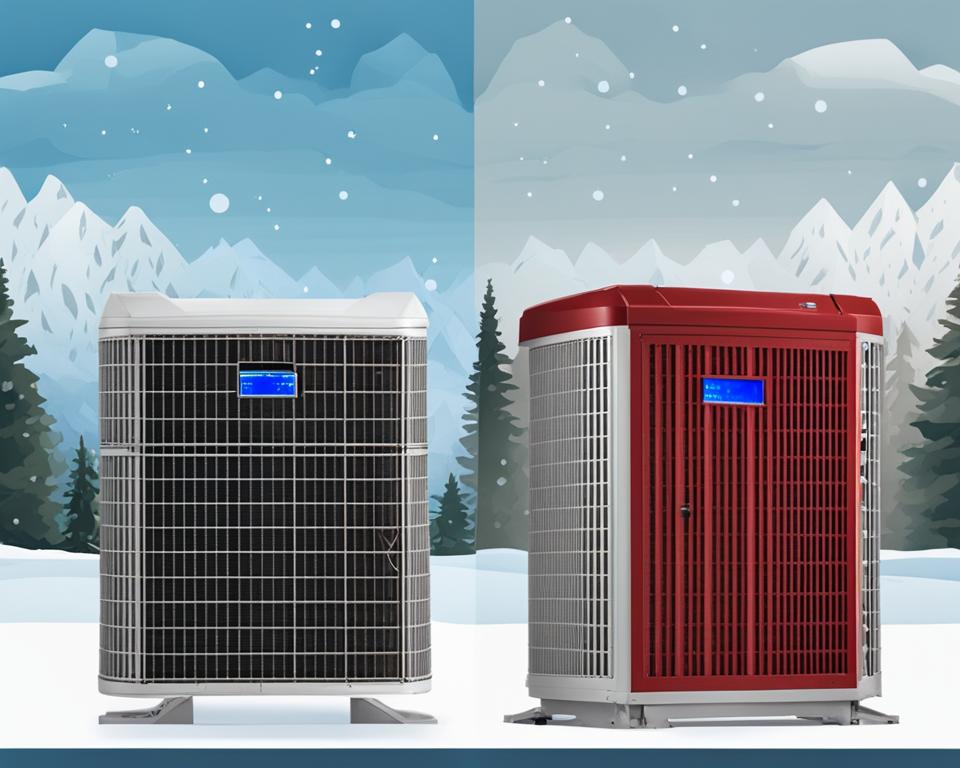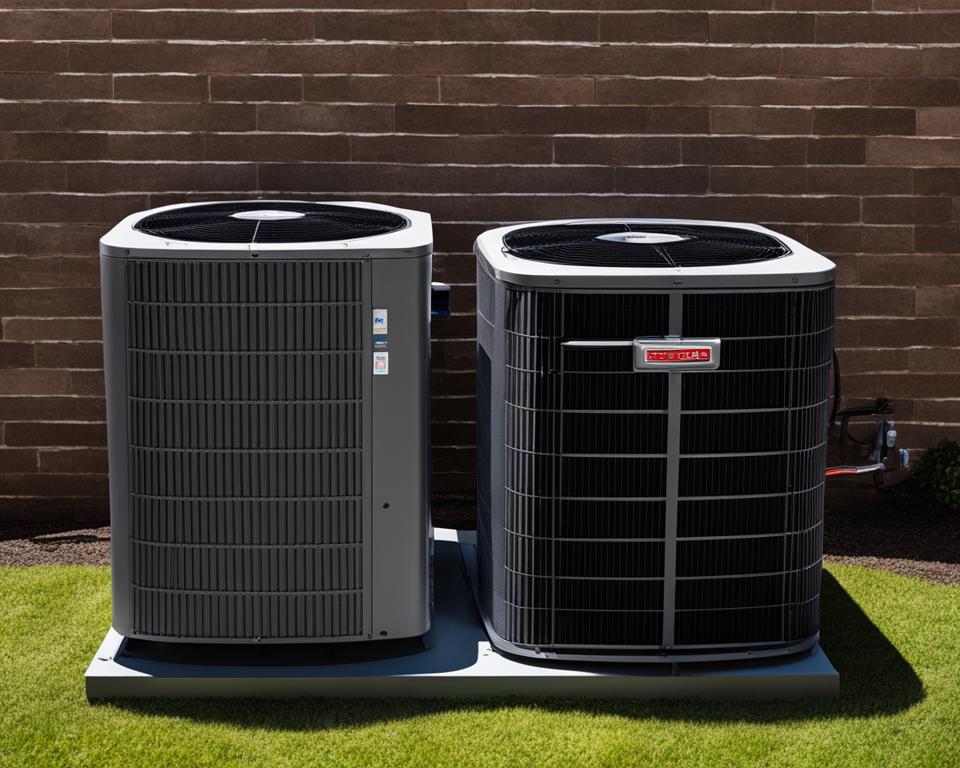When it comes to choosing an air conditioner for your home, understanding the differences between a single stage and two stage AC system is crucial. The efficiency of your AC system can impact both your comfort and energy bills, so it’s important to make an informed decision.
A single stage AC operates with a compressor that has only one speed – it is either running at 100% capacity or completely off. This means that the AC is constantly turning on and off to maintain the desired temperature, which can lead to higher energy consumption and potentially higher bills. On the other hand, a two stage AC has a compressor with two speeds – 100% and around 70% capacity. This allows the AC to operate at a lower speed when the temperature is close to the desired setting, resulting in improved efficiency and energy savings.
Key Takeaways:
- A single stage AC has a compressor with only one speed, while a two stage AC has a compressor with two speeds.
- A two stage AC operates at a lower speed when the temperature is close to the desired setting, leading to improved efficiency.
- A two stage AC can save on energy costs compared to a single stage AC.
- One of the main advantages of a single stage AC is its lower initial cost.
- Consult with an HVAC professional to determine which AC system is best suited for your needs and budget.
Differences Between One-Stage and Two-Stage Air Conditioners
When it comes to choosing the right air conditioner for your home, understanding the differences between a one-stage and two-stage AC system is key. Let’s dive into these differences to help you make a well-informed decision.
Understanding the Compressor
The main distinction between a one-stage and two-stage AC system lies in the compressor. A one-stage AC system has a compressor that operates at a single speed – either 100% or completely off. On the other hand, a two-stage AC system features a compressor with two distinct speeds – 100% and around 70% capacity.
“A two-stage AC system offers performance benefits that a single-stage AC system cannot match,” explains HVAC expert, John Thompson. “By operating at different speeds, a two-stage AC can adjust its cooling capacity more precisely to meet your comfort needs.”
Thanks to its two-stage compressor, the two-stage AC system works less hard and consumes less energy when the temperature is close to the desired setting. This increased efficiency allows for greater energy savings and a more comfortable indoor environment.
Now, let’s take a closer look at the advantages and disadvantages of each system.
One-Stage AC: Pros and Cons
A one-stage AC system has its advantages. It typically has a lower initial cost compared to a two-stage system, making it an attractive option for budget-conscious homeowners. Additionally, a properly sized and installed one-stage AC can effectively cool your home.
However, there are drawbacks to consider. One-stage AC systems run at full power all the time, regardless of the cooling demands. This constant operation can lead to higher energy bills. Moreover, the frequent starting and stopping of the compressor can cause more noise and potential discomfort for some homeowners.
Two-Stage AC: Pros and Cons
A two-stage AC system offers enhanced efficiency compared to its one-stage counterpart. It provides a middle ground between low-end and high-end efficiency while delivering greater comfort.
With its two-stage compressor, the AC system can adjust its cooling capacity based on the temperature needs of your home. When the temperature is close to the desired setpoint, the compressor operates at a lower speed, consuming less energy. This results in reduced energy costs without compromising on indoor comfort.
“The two-stage AC system strikes a balance between efficiency and affordability,” says Sarah Davis, HVAC specialist. “It’s a popular choice for homeowners seeking improved performance while being mindful of their budget.”
It’s important to consult with an HVAC professional to determine if a two-stage AC system is the right fit for your cooling needs and budgetary constraints.
Choosing the Right AC System
When deciding between a one-stage and two-stage AC system, the choice ultimately depends on your specific requirements. If you’re looking for a cost-effective option and don’t mind the constant operation, a one-stage AC might be suitable. On the other hand, if you prioritize energy efficiency and enhanced comfort, a two-stage AC system is worth considering.
Remember, investing in the right AC system can lead to long-term savings and a more comfortable living space. Consult with an HVAC professional who can assess your home’s needs and guide you towards the best AC system for your unique situation.
| One-Stage AC | Two-Stage AC |
|---|---|
| Lower initial cost | Enhanced energy efficiency |
| Constant operation at full power | Adjustable cooling capacity |
| Less control over comfort | Improved indoor comfort |
| Potential for higher energy bills | Energy-saving potential |
Differences Between Two-Stage and Variable-Speed Air Conditioners
When it comes to air conditioning options, two-stage and variable-speed systems offer advanced features that enhance efficiency and comfort. While both options provide superior performance compared to single-stage ACs, there are key distinctions to consider. Let’s explore the differences between two-stage and variable-speed air conditioners to help you make an informed decision for your home.
Two-Stage Air Conditioners
A two-stage air conditioner operates with two compressor speeds: 100% capacity and around 70% capacity. This allows the system to adjust its cooling output based on the temperature needs of your home. When the weather is mild, the compressor runs at the lower speed, using less energy and providing optimal comfort. On hotter days, it ramps up to full capacity for maximum cooling power. This two-stage operation results in improved energy efficiency and reduced wear and tear on the system.
Variable-Speed Air Conditioners
A variable-speed air conditioner takes efficiency and comfort to the next level. With up to 700 distinct compressor settings, these systems provide precise control over airflow and temperature regulation. Variable-speed ACs continuously adjust their power usage based on the cooling requirements of your home, ensuring optimal energy efficiency at all times. This granular control allows for a more stable and consistent indoor climate while minimizing operating costs.
“Variable-speed air conditioners deliver exceptional energy efficiency and customizable comfort. With their ability to adapt to changing cooling demands, they provide the perfect balance between performance and cost savings.”
While both two-stage and variable-speed air conditioners offer superior efficiency compared to single-stage systems, the distinction lies in the degree of control and precision. Two-stage ACs provide two fixed compressor speeds, while variable-speed ACs offer a wide range of adjustable settings. The table below summarizes the differences:
| Feature | Two-Stage AC | Variable-Speed AC |
|---|---|---|
| Compressor Speed Options | Two (100% and 70% capacity) | Up to 700 settings |
| Precision Control | Limited | Highly precise |
| Energy Efficiency | Improved | Optimal |
| Comfort | Enhanced | Customizable |

With their comprehensive compressor speed options and precise control, variable-speed air conditioners offer the highest levels of energy efficiency and customizable comfort. These systems adjust their output to match the specific needs of your home, resulting in optimal performance while minimizing energy consumption. If energy efficiency and personalized comfort are top priorities, a variable-speed air conditioner may be the ideal choice for you.
Pros and Cons of One-Stage AC
One-stage AC systems have their pros and cons when it comes to cooling your home. Understanding these advantages and drawbacks can help you make an informed decision. Let’s take a closer look at the benefits and limitations of one-stage AC systems.
Pros of One-Stage AC
- Lower initial cost: One of the significant advantages of one-stage AC systems is their affordability. These systems typically have a lower upfront cost compared to two-stage or variable-speed AC units, making them a budget-friendly option for homeowners.
- Effective cooling: Despite their simplistic design, one-stage AC systems can effectively cool your home when properly sized and installed. When operating at full capacity, they can provide adequate cooling comfort in hot weather conditions.
Cons of One-Stage AC
- Less energy efficient: One-stage AC systems continuously run at 100% power, regardless of the cooling requirements. This constant operation can lead to higher energy bills, especially in situations where less cooling power is needed.
- Noisy operation: The frequent starting and stopping of the compressor in one-stage AC systems can result in noise disturbances. This can be potentially annoying for homeowners, particularly if the AC unit is located near living spaces or bedrooms.
Despite their limitations, one-stage AC systems are still a viable option for homeowners looking for a cost-effective cooling solution. However, it’s crucial to weigh the advantages and disadvantages carefully to ensure that the chosen AC system aligns with your cooling needs and long-term energy efficiency goals.

Pros and Cons of Two-Stage AC
Two-stage AC systems offer improved efficiency compared to one-stage AC systems. They provide a middle ground between low-end and high-end efficiency and can save on energy costs.
Here are the pros and cons of two-stage AC:
Pros of Two-Stage AC:
- Higher Efficiency: Two-stage AC systems are designed to operate at two distinct speeds, allowing them to adjust their cooling capacity according to the current demand. This results in efficient energy usage and enhanced comfort.
- Better Humidity Control: Two-stage ACs can dehumidify the air more effectively than single-stage units. The longer, low-capacity operation cycles allow for better moisture removal, preventing excess humidity in your home.
- Lower Operating Noise: The two-stage compressor operates at a lower capacity most of the time, resulting in reduced noise levels compared to a single-stage unit. This makes it a suitable choice for homeowners who value a quieter indoor environment.
- Longer Lifespan: Due to their ability to run at lower capacities, two-stage ACs experience less strain on the system, which can contribute to a longer lifespan when properly maintained.
Cons of Two-Stage AC:
- Higher Initial Cost: Two-stage AC systems generally come with a higher price tag compared to single-stage units. The cost may be more comparable to variable-speed systems, depending on the brand and model selected.
- Potential Overcooling: In some cases, the two-stage AC may enter the second stage unnecessarily, leading to overcooling and potential energy waste. Proper installation and regular maintenance can help mitigate this issue.
- Potential Incompatibility: Upgrading to a two-stage AC may require additional compatible components, such as a compatible furnace or air handler, which could add to the overall cost of the system.
To determine if a two-stage AC system is the right fit for your budget and cooling needs, it is crucial to consult with an HVAC professional. They can assess your home’s requirements and provide personalized recommendations.
It’s important to weigh the pros and cons of a two-stage AC system to make an informed decision. Consider factors such as energy efficiency, long-term savings, noise levels, and initial costs. A professional HVAC consultation can help you choose the best air conditioning system for your home.
Remember, finding the right AC system is essential to maintaining optimal indoor comfort while minimizing energy consumption.

| Pros of Two-Stage AC | Cons of Two-Stage AC |
|---|---|
| Higher Efficiency | Higher Initial Cost |
| Better Humidity Control | Potential Overcooling |
| Lower Operating Noise | Potential Incompatibility |
| Longer Lifespan |
Pros and Cons of Variable-Speed AC
Variable-speed AC systems are the pinnacle of efficiency and quiet operation in the air conditioning industry. These advanced systems offer numerous benefits that contribute to optimal comfort and energy savings. However, it’s important to consider the potential drawbacks before making a decision. Let’s explore the pros and cons of variable-speed AC systems:
Pros of Variable-Speed AC
- Maximum Efficiency: Variable-speed AC systems are designed to adapt to the specific cooling needs of your home. With up to 700 distinct compressor settings, these systems can adjust their power usage to match the demand, resulting in significant energy savings.
- Precise Temperature Control: Variable-speed ACs offer precise temperature control, allowing you to set and maintain your desired comfort level with accuracy. The system can operate at lower speeds for longer periods, ensuring consistent cooling without dramatic temperature fluctuations.
- Quiet Operation: Thanks to their ability to operate at lower speeds, variable-speed ACs generate significantly less noise compared to traditional AC systems. This leads to a quieter and more peaceful indoor environment.
- Enhanced Comfort: Variable-speed AC systems provide consistent airflow and temperature control, eliminating hot and cold spots in your home. This ensures a more comfortable living environment for you and your family.
Cons of Variable-Speed AC
- Higher Initial Cost: Variable-speed AC systems typically come with a higher upfront cost compared to single-stage or two-stage AC systems. The advanced technology and additional components contribute to the increased price.
- Potential Higher Repair Costs: With the complexity of variable-speed AC systems, the potential for higher repair costs exists. These systems require specialized knowledge and expertise for maintenance and repairs, which can be more expensive compared to traditional AC systems.
Despite the higher initial cost and potential higher repair costs, variable-speed AC systems offer unparalleled energy efficiency, precise temperature control, and whisper-quiet operation, making them an excellent choice for those who prioritize comfort and long-term energy savings.
| Pros of Variable-Speed AC | Cons of Variable-Speed AC |
|---|---|
| Maximum Efficiency | Higher Initial Cost |
| Precise Temperature Control | Potential Higher Repair Costs |
| Quiet Operation | |
| Enhanced Comfort |
Why Your Furnace Type Matters
Your furnace type plays a crucial role in determining the compatibility of your AC system. The blower motor in your furnace regulates airflow in the entire system, including the air conditioned by the AC unit. This means that the type and capacity of your furnace can affect the performance and efficiency of your air conditioning system.
If you’re considering upgrading to a two-stage or variable-speed AC system, it’s important to evaluate your current furnace or air handler. These advanced AC systems require a compatible furnace with the ability to handle varying air flows and settings. Upgrading your furnace may be necessary to ensure optimal performance and energy efficiency.
Assessing the age and condition of your existing furnace is crucial in determining the best course of action. If your furnace is old and nearing the end of its lifespan, it may be more cost-effective to replace both the AC unit and furnace simultaneously. This allows for seamless integration and maximizes the potential benefits of the new AC system.
Upgrade Your Furnace for Enhanced Performance
By upgrading your furnace along with your AC system, you can experience several benefits:
- Improved energy efficiency: Newer furnaces are designed to work more efficiently, reducing energy consumption and lowering utility costs.
- Enhanced comfort: A properly sized and matched furnace and AC system can provide consistent and comfortable airflow throughout your home.
- Long-term savings: Investing in a high-efficiency furnace can lead to long-term savings on energy bills.
- Peace of mind: Upgrading both the AC and furnace ensures that your entire HVAC system is modern and reliable, reducing the risk of breakdowns and costly repairs.
“Upgrading your furnace alongside your AC system is a smart investment in long-term energy savings and comfort.”
Consult with an HVAC professional to assess your current furnace and determine the best course of action. They can provide expert advice and recommendations based on your specific needs and budget. Remember, upgrading your furnace is an investment that can significantly impact the performance and efficiency of your AC system.
Now that we’ve explored why your furnace type matters, let’s dive into the pros and cons of one-stage AC systems.
Conclusion
Choosing the right air conditioning system for your home is a decision that requires careful consideration. When comparing single stage and two-stage AC systems, it’s important to take into account factors such as your budget, cooling needs, and desired energy efficiency.
While single stage AC systems are more affordable, two-stage and variable-speed AC systems offer enhanced efficiency and comfort. These systems have the ability to adjust their compressor speeds according to the temperature, resulting in energy savings and optimal indoor comfort.
To make an informed decision, it is strongly recommended to consult with an HVAC professional who can assess your specific requirements and recommend the best system for your home. Remember, the goal is to achieve optimal indoor comfort while minimizing energy consumption, ensuring both comfort and cost savings.
FAQ
What is the main difference between a single stage and two stage AC system?
The main difference lies in the compressor. A single stage AC has a compressor that operates at one speed, while a two stage AC has a compressor with two distinct speeds.
How does the efficiency of a two stage AC compare to a single stage AC?
A two stage AC offers improved efficiency compared to a single stage AC due to its ability to work less hard and use less energy when the temperature is close to the desired setting.
What is the advantage of a variable-speed AC system?
A variable-speed AC system allows for precise control over airflow and temperature, resulting in even greater energy efficiency and comfort for your home.
What are the pros and cons of a single stage AC?
The main benefit of a single stage AC is its lower initial cost, but it tends to be less efficient and can lead to higher energy bills. The frequent starting and stopping of the compressor can also be noisy for some homeowners.
What are the advantages of a two stage AC?
Two stage AC systems offer improved efficiency compared to one-stage systems and provide a middle ground between low-end and high-end efficiency.
What are the advantages of a variable-speed AC?
Variable-speed AC systems are the most efficient and quietest option available, offering precise control over temperature and energy usage for maximum comfort and energy savings.
Why does your furnace type matter when choosing an AC system?
The blower motor in your furnace regulates airflow in the entire system, including the air conditioned by the AC unit. To install a two-stage or variable-speed AC system, you may need to upgrade your furnace or air handler.
How should you choose between a single stage and two stage AC system?
Factors such as budget, cooling needs, and desired energy efficiency should be considered. While single stage ACs are more affordable, two-stage and variable-speed ACs offer greater efficiency and comfort. It is important to consult with an HVAC professional to determine the best option for your home.
What is the conclusion of the comparison between single stage and two stage AC systems?
Choosing between a single stage and two stage AC system ultimately depends on your budget, cooling needs, and desired energy efficiency. While single stage ACs are more affordable, two-stage and variable-speed ACs offer greater efficiency and comfort. Consulting with an HVAC professional is essential to determine the best option for your home.
